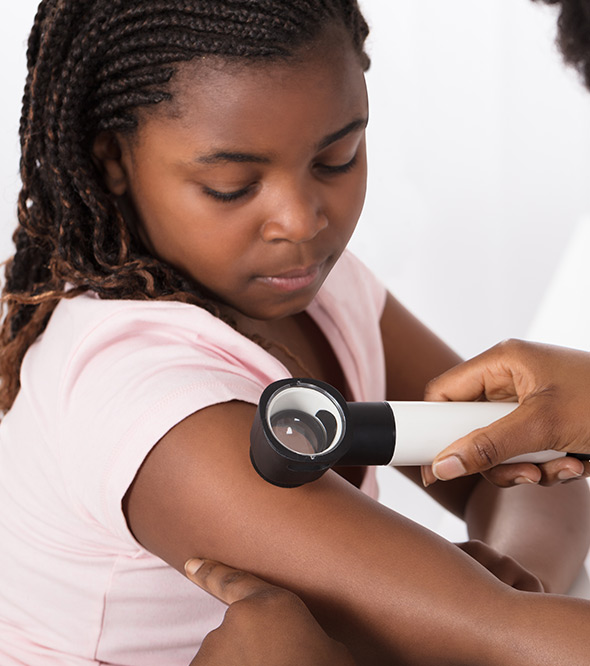Treatment for Melanoma in Children
The incidence of melanoma, one of the most harmful forms of skin cancer, is increasing among children and teenagers. In fact, the rate of melanoma has doubled during the past 20 years.
While melanoma represents only about 5% of all skin cancers in the United States, it accounts for about 75 % of all skin cancer deaths. If detected early, melanomas have a high cure rate. However, in an advanced stage, it can spread to other organs of the body.
Melanoma’s unique manifestation in children sets it apart from its presentation in adults. Childhood is crucial for developing moles, an important melanoma risk factor. Regular skin check-ups are recommended for children with a family or personal history of skin cancer.
If your child or a loved one is at increased risk of developing pediatric melanoma or experiencing unusual mole development, we are here to help. Continue reading to learn more.


Understanding Pediatric Melanoma
Melanoma is a severe form of skin cancer that begins in the melanocytes, which are special cells that give color to our skin, hair, and eyes. When these cells become cancerous, they can lead to melanoma.
To understand pediatric melanoma, knowing a bit about how our skin works is helpful.
Our skin is the body’s largest organ and has different layers, each with specific jobs. Melanocytes are found in the deepest layer of our skin and are crucial in protecting us from the sun’s harmful ultraviolet (UV) rays. They make a pigment called melanin, which gives our skin its color and provides some natural protection against UV damage. However, even with this protection, the sun’s UV rays can still harm our skin, especially when we’re kids. Too much sun exposure during childhood can sometimes lead to changes in melanocytes, possibly resulting in a melanoma diagnosis.
One of the important aspects of a childhood melanoma diagnosis is the presence of one or more spots on your skin. Often considered harmless, they may be more serious if they include irregular edges, changes in color, or an increase in size or shape.
Learning to tell the difference can help doctors find melanoma early and treat it successfully.
Childhood Melanoma Signs and Symptoms
When recognizing melanoma in children, it’s essential to be aware of the common signs and symptoms. Melanoma in children might not always look the same as in adults, making early detection even more crucial.
Common signs and symptoms include:
- Unusual moles that may be larger have irregular edges or have multiple colors
- An existing mole that changes in size, shape, or color or begins to bleed
- New moles that appear after age 4
- Any mole or spot that itches, bleeds, or hurts
- A sore that does not heal within a few weeks
- Raised lumps or bumps on the skin’s surface
- Dark lines on nails, hands, feet, or in the mouth
Identifying the early warning signs of melanoma is essential, and knowing when to worry about a mole on a child is crucial for early diagnosis and successful treatment.
Pediatric melanoma can be more challenging to detect, but being vigilant and examining any unusual skin changes promptly is the best way to ensure a child’s health and well-being.
Diagnosing Childhood Skin Cancer
Biopsy is a crucial step in diagnosing pediatric skin conditions, including melanoma. It allows doctors to examine the removed tissue under a microscope to determine if it’s cancerous.
For children, biopsy is the gold standard in confirming a melanoma diagnosis.
A child may receive four main types of biopsies for a suspected melanoma diagnosis. They include:
- Excisional Biopsy: The entire mole or suspicious area is removed in this procedure. It’s the most common method for diagnosing melanoma. The tissue is then sent to a laboratory for analysis.
- Incisional Biopsy: An incisional biopsy may be performed if a mole is too large to remove entirely. In this case, only a portion of the mole is removed for examination.
- Punch Biopsy: A punch biopsy tool removes a small, circular section of the mole or skin lesion. This method is suitable for smaller moles.
- Shave Biopsy: A shave biopsy may be performed for surface-level moles. A scalpel shaves off the top layers of the mole for further examination.
During the biopsy, our dermatologists assess the type of melanoma, its depth, and whether it has spread. This information guides the treatment plan, ensuring the best approach to care.
Treatment Options for Childhood Melanoma
In cases of early-stage melanoma, our experienced dermatologists often perform a specialized procedure known as an excision. During this procedure, they remove the melanoma and a margin of healthy tissue surrounding it to ensure all cancerous cells are taken out. This step minimizes the chance of the cancer returning. When the melanoma is small and localized, excision can offer a high cure rate.
In more advanced cases of melanoma, where the cancer may have spread to other parts of the body, specialized treatment is necessary. Our team, dedicated to your child’s well-being, will refer you to a specialist who is an expert in treating advanced melanoma.
These specialists are often oncologists, surgeons, or other medical professionals with extensive experience managing complex pediatric melanoma cases.
Depending on the specific circumstances, they will work closely with you to create a tailored treatment plan that may include surgery, chemotherapy, immunotherapy, targeted therapy, or radiation.
Risk Factors for Pediatric Melanoma
Understanding the risk factors associated with pediatric melanoma is essential in protecting your child’s skin health and overall well-being.
Common risk factors include:
- A family history of melanoma or other skin cancers, especially among first-degree relatives like parents or siblings
- Prolonged exposure to harmful ultraviolet (UV) rays from the sun
- Living in sunny regions or spending extended periods outdoors without proper sun protection
- Children with fair skin are generally more susceptible to the harmful effects of UV radiation
- Numerous moles, especially atypical or dysplastic
- Experiencing severe sunburns, especially during childhood
- Conditions or treatments that weaken the immune system
- A personal history of skin cancer
- Tanning bed use
Preventing Melanoma in Children
Shielding your child from the risk of melanoma begins with taking proactive measures.
Sun safety practices are crucial in preventing skin cancer, especially in children.
To reduce your child’s risk of developing pediatric melanoma, you should:
- Ensure your child wears sunscreen with SPF 30 or higher, protective clothing (hats, long sleeves), and sunglasses when outdoors.
- Discourage using tanning beds, which increases the risk of skin cancer.
- Conduct regular skin examinations and be aware of any changes in moles or skin lesions.
- Consult a dermatologist if you notice any concerning changes or have a family history of melanoma.
- Keep your child well-hydrated, especially during hot and sunny days.
- Choose lightweight, long-sleeved clothing that covers the skin while allowing breathability.
- Educate your child about the dangers of excessive sun exposure and UV radiation.
- Set up shade structures when spending time outdoors, such as beach umbrellas or canopies.
- Be a role model by practicing sun safety yourself, demonstrating its importance.
- Teach your child how to apply sunscreen effectively and reapply as needed.
- Avoid outdoor activities during peak sun hours when possible.
These measures can significantly reduce the risk of pediatric melanoma and promote overall skin health in children.
Timely and Complete Care for Melanoma in Children
When it comes to your child’s health, we prioritize offering the most effective, comprehensive care.
Our experienced team is here to provide comprehensive treatment for all your medical dermatology needs. If your family is facing a pediatric melanoma diagnosis, rest assured that we’re here to guide you every step of the way.
Your child’s well-being is our top concern, and we’re committed to providing the best care possible.
